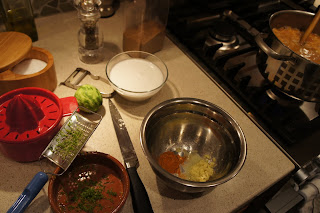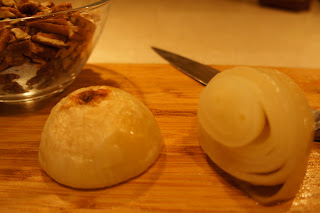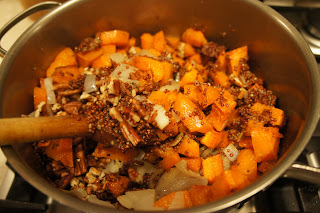Red wines from the Jura are most often light to medium bodied and resemble a rustic and earthy pinot noir from Burgundy, since Jura is situated right next to Burgundy.
Jura wines are all the rage these days in New York City, thank goodness. Here are a few articles to learn more about them:
- One by Eric Asimov from the New York Times
- One by Anne Glusker in the Travel section of the New York Times again
- One historical article by Samuel Chamberlain for Gourmet Magazine, published in 1951
- One more recent by Tara Thomas for Gourmet Magazine again
If you are lucky enough to come across a wine from the Jura in your local wine store, red or white, don't think twice and buy it. Just email me if you need pairing suggestions. The names on the label could be Arbois or Cotes du Jura (or Cremant du Jura for a light sparkling white) and any producer you can find here in the U.S. will surely be a good one, so don't worry about picking a lemon.
Chantal & Jean Berthet-Bondet are the producers of my particular wine today. They are relatively new producers as they took over in 1985 an estate that had been dormant for about 50 years.
The wine is named rubis and is a blend of Trousseau, Poulsard (2 grapes unique to the Jura I believe) and Pinot Noir. All three grapes give (again) light to medium bodied wines, rather light in color, with red berries and earthy notes. It will pair well with grilled and smoked meat, charcuterie and cheese plates of Comte, Gruyere and Morbier. Its retail price is about $20.
Last night, I chose to pair my light red Cotes du Jura with homemade... Indian cuisine. Because it is quite a versatile wine! So, pourquoi pas? And by the way, this dish is absolutely delicious (... like I would ever post the recipe for something yucky, right?). Vegetarians may choose to stick to the coconut lentil stew, and omnivores will complement the stew with coconut baked fish. Either way, drink either a light red (Jura or not) with this meal, like a French pinot noir/Burgundy, or a dry or better yet, off-dry white from the Loire Valley (Chenin Blanc grapes).
Coconut Lentil Stew and Baked Salmon: (Dahl de Lentilles et Saumon en Papillotes au Lait de Coco)
For 4 people
200g red lentils, soaked in water for 6 to 8 hours
3/4 cup coconut milk
1 1/2 cups water
400g or one small can crushed tomatoes
1 medium onion
1 tbsp cardamon powder (or 10 cardamon seeds)
1 tbsp cumin
About 1 inch long piece of ginger, peeled and grated
Vegetable oil
Salt
Green pepper
Indian/ Basmati rice, steamed (enough for 4 people)
Peel and chop the onion and brown it in vegetable oil in a big pan. Add all the spices and cook together for 2 minutes.
Throw in the lentils, the tomatoes and 1 1/2 cups water. Bring to a boil, then simmer on low heat for 20 minutes, or until the mixture becomes quite soupy.
Stir in the coconut milk with a wooden spoon and cook on low heat for 5 more minutes.
Serve over rice.
It is possible to throw this lentil stew in a blender to smooth it before serving.
4 salmon fillets
3/4 cup of coconut milk
5 tsp ground coriander
zest and juice of a lime
4 tbsp of olive oil
1/2 tsp cayenne pepper
About 1-inch long piece of fresh ginger, peeled and grated
Salt
Green pepper
In a small bowl, mix together all the ingredients except the salmon fillets.
Cut squares of aluminum foil (about 10X10 inches). On each piece of foil, drop one tablespoon of oil, put one salmon fillet, which needs to be slathered with the oil, then salted and peppered well.
Cover with 1/4 of the coconut marinade, and seal the foil package.
Repeat this procedure with the other fillets.
Bake for 25 minutes on 350F.
Serve with the lentil stew and a few basil leaves.
 |
| Beautiful red lentils |
 |
| Preparing the spices for the lentil stew |
 |
| You say tomAto... |
 |
| Spices & zest |
 |
| Lentil dahl |
 |
| Spiced up coconut marinade |
 |
| Preparing the foil packages |
 |
| Salmon in its marinade |
 |
| Foil package is "papillote" in French |
 |
| Last step in the stew recipe: adding in the coconut milk |
 |
| Ready to serve |
 |
| Cheers! |
This Berthet Bondet Cotes du Jura was a pale ruby color with hints of garnet on the rim.
It had youthful, medium intensity aromas of red berries (strawberries and red currants),
dirt and gravel, moss, bramble, nutmeg & white pepper, tree bark, dried mushrooms and a hint of manure (I did say it was rustic!).
It is dry, with medium to medium plus acidity, medium minus soft tannins, medium intensity of flavors and medium minus alcohol. Flavors of strawberries and red currants mingle with moss, tree bark, dried mushrooms, nutmeg, white pepper, and a hint of eucalyptus on the finish. The medium plus length is carried by the zingy acidity.
A light, well-balanced, rustic, though still elegant wine, whose acidity counteracts the spices of my Indian dish.











































